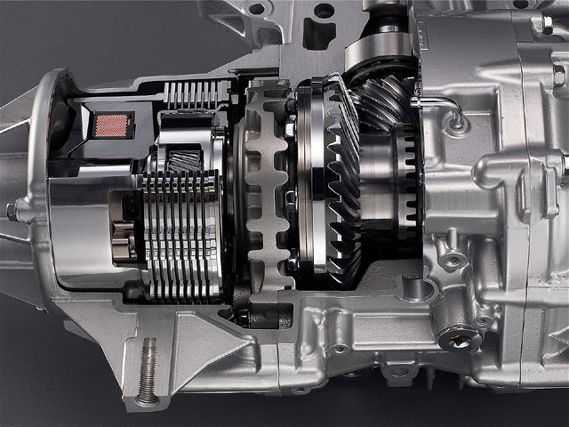 | On All Fours - Wrenchin' All-Wheel-Drive Tech
| On All Fours - Wrenchin' All-Wheel-Drive Tech
We're all familiar with the electronic handling enhancement systems that now appear on luxury cars. These generally use existing ABS systems to apply braking to any wheel that is turning at an inappropriate rate, to eliminate wheel slip and improve tracking through corners. (Honda has a similar system called Vehicle Stability Assist, or VSA). These systems actually work well for improving safety.
But Honda's Super-Handling system (SH-AWD) is different. It is an active, mechanical system that works on the rear axle. It combines the advantages of all-wheel drive with the ability to drive wheels on different sides of the car at different speeds. So during cornering, the rear wheels-particularly the outside rear-can be mechanically accelerated.
The result is an uncanny ability to steer through corners under power.
The system works using two identical electromagnetic clutches on either side of the rear axle. They control the amount of drive torque that reaches each wheel and function as a limited-slip differential system. The amount of torque transmitted to each rear wheel can vary continuously between zero and 100 percent of the available rear axle torque, depending on how the car is being driven.
Ahead of the rear axle and clutch system is an electronically variable overdrive unit Honda calls an "acceleration device." It normally allows power to pass through at a 1:1 ratio. When conditions dictate however, it accelerates the output shaft heading for the rear axle by up to five percent.
The use of the acceleration device, along with electromagnetic clutches, creates the ability to make the outside rear wheel turn faster in a hard corner. This relieves the front tires of some of the turning load, reducing the tendency to understeer. Total cornering grip is increased.
A conventional all-wheel-drive system links the in-board and outboard rear tire speeds to maintain traction under power. With both wheels equalized at the rear, straight-line acceleration is much improved. This linking effect complicates turning, however, adding to the job of turning the car strictly through the steering angle of the front wheels. SH-AWD, by using a pushing rear wheel to actually help turn the car, helps unload the front wheels and makes handling much more neutral and responsive.
We tossed around a new RL to get a feel for SH-AWD. The car will routinely track smoothly through curves, but the system comes into play as cornering g's increase. To invoke the system at its limit, we had to enter the curves hot, deliberately early-apexing the corner, then hit full power. The car responds by squatting in the rear, taking a set, and exiting in a startlingly predictable manner. Where we expected fishtailing, there was no slip, no need to correct steering. We were able to induce tire chirp, but it never seemed to affect the directional stability of the car. In short, the SH-AWD system felt good-really good. Like it was the first time.
Alas this system, although mechanical, would not lend itself to transplanting to, say, a Civic (In case some of you masochists out there had swap intentions. - DF). Three ECU processors are required, and the logic behind them is unique. However, we won't be surprised to see Honda apply SH-AWD to more products in the future.
